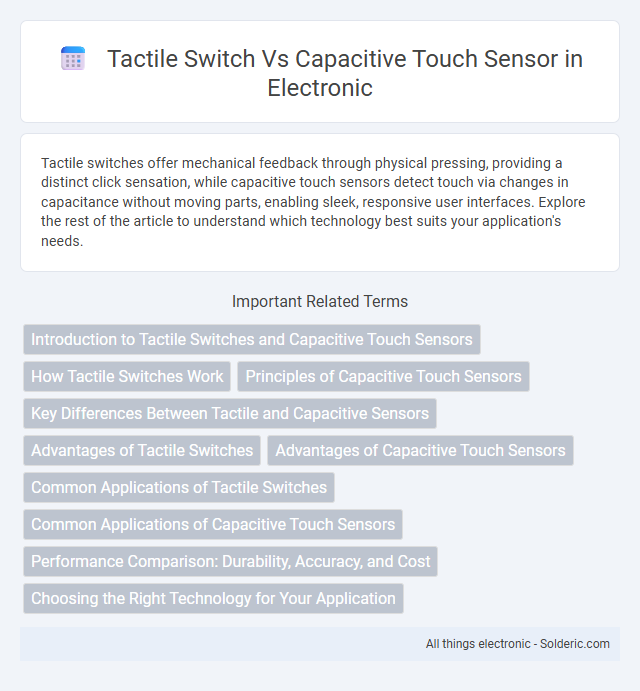Tactile switches offer mechanical feedback through physical pressing, providing a distinct click sensation, while capacitive touch sensors detect touch via changes in capacitance without moving parts, enabling sleek, responsive user interfaces. Explore the rest of the article to understand which technology best suits your application's needs.
Comparison Table
| Feature | Tactile Switch | Capacitive Touch Sensor |
|---|---|---|
| Operating Mechanism | Physical mechanical press | Detects changes in capacitance |
| Durability | Lower; prone to wear | Higher; no moving parts |
| Response Time | Instant | Fast, but slightly delayed |
| Cost | Low | Moderate to high |
| Installation | Requires mechanical mounting | Can be embedded under surfaces |
| Use Cases | Keyboards, simple buttons | Smartphones, touch panels |
| Power Consumption | Minimal (passive switch) | Requires power for sensing |
| Environmental Resistance | Susceptible to dirt, moisture | Better resistance, sealed design |
| Actuation Force | Physical force needed (50-200 grams) | No physical force needed |
| Feedback | Tactile and audible click | Usually visual or haptic feedback externally |
Introduction to Tactile Switches and Capacitive Touch Sensors
Tactile switches are mechanical components that provide physical feedback through a clicking sensation when pressed, commonly used in keyboards and control panels. Capacitive touch sensors detect changes in capacitance caused by the presence of a finger, offering a seamless, button-less user interface often found in smartphones and touchscreens. Your choice between these technologies depends on the need for tactile feedback versus a sleek, modern design with no moving parts.
How Tactile Switches Work
Tactile switches operate through mechanical movement, where pressing the switch causes a physical contact between conductive materials, completing the circuit and registering an input. These switches provide tactile feedback, allowing you to feel a click or physical response when activated, which enhances user interaction and accuracy. Unlike capacitive touch sensors that rely on detecting changes in capacitance, tactile switches depend on direct, mechanical action to function.
Principles of Capacitive Touch Sensors
Capacitive touch sensors operate by detecting changes in the electrostatic field when a conductive object, like Your finger, comes into proximity, causing a variation in capacitance that the sensor measures. Unlike tactile switches that rely on physical pressure to actuate, capacitive sensors provide contactless input, enabling seamless, wear-resistant interfaces. Their principle allows for multi-touch recognition and improved durability, making them ideal for modern touch-sensitive applications.
Key Differences Between Tactile and Capacitive Sensors
Tactile switches require physical pressure to close a circuit, offering tactile feedback through mechanical movement, while capacitive touch sensors detect changes in capacitance caused by a conductor like your finger without physical force. Tactile sensors are reliable in harsh environments and provide clear, audible clicks, whereas capacitive sensors enable sleek, touch-sensitive interfaces and support multi-touch gestures. Your choice depends on application needs, durability, and user experience preferences between mechanical feedback or seamless touch interaction.
Advantages of Tactile Switches
Tactile switches offer reliable physical feedback through a mechanical click, ensuring precise user input in various electronic devices. They excel in durability, with typical lifespans ranging from 1 to 10 million actuations, making them ideal for heavy-use applications. Their straightforward design simplifies integration and reduces production costs compared to capacitive touch sensors, which require more complex circuitry and sensitivity calibration.
Advantages of Capacitive Touch Sensors
Capacitive touch sensors offer enhanced durability due to the lack of moving parts, reducing mechanical wear and tear compared to tactile switches. They provide higher sensitivity and faster response times, allowing more precise and seamless user interactions. Your device benefits from a sleek, modern design with improved aesthetics and easier maintenance when using capacitive touch technology.
Common Applications of Tactile Switches
Tactile switches are commonly used in electronic devices such as keyboards, remote controls, and industrial machinery for precise, tactile feedback during user input. They excel in applications requiring physical button presses for reliable on/off states, including automotive controls, consumer electronics, and medical instruments. Unlike capacitive touch sensors, tactile switches provide a distinct mechanical click, enhancing user confidence in environments where touch sensitivity may be compromised.
Common Applications of Capacitive Touch Sensors
Capacitive touch sensors are commonly used in smartphones, tablets, and touchscreen monitors due to their high sensitivity and multi-touch capabilities. These sensors are integral to wearable devices and automotive control panels, providing a sleek, durable interface without mechanical parts. Their widespread application in home automation systems enhances user experience with intuitive control over lighting, climate, and security features.
Performance Comparison: Durability, Accuracy, and Cost
Tactile switches offer high durability with millions of guaranteed actuations and provide precise tactile feedback, making them highly accurate for physical input but can wear out mechanically over time. Capacitive touch sensors excel in responsiveness and multi-touch accuracy, with no moving parts, resulting in longer lifespan and lower maintenance but typically come at a higher initial cost. Choosing between the two depends on your performance needs, balancing tactile reliability against the modern, sleek interface and longevity of capacitive technology.
Choosing the Right Technology for Your Application
Choosing the right technology between tactile switches and capacitive touch sensors depends on the specific application requirements, such as durability, user experience, and environmental conditions. Tactile switches provide reliable physical feedback and are ideal for applications needing precise mechanical actuation and robustness in harsh environments. Capacitive touch sensors offer a sleek, modern interface with no moving parts, suitable for high-end consumer electronics where seamless integration and multi-touch capability are priorities.
Tactile switch vs capacitive touch sensor Infographic

 solderic.com
solderic.com